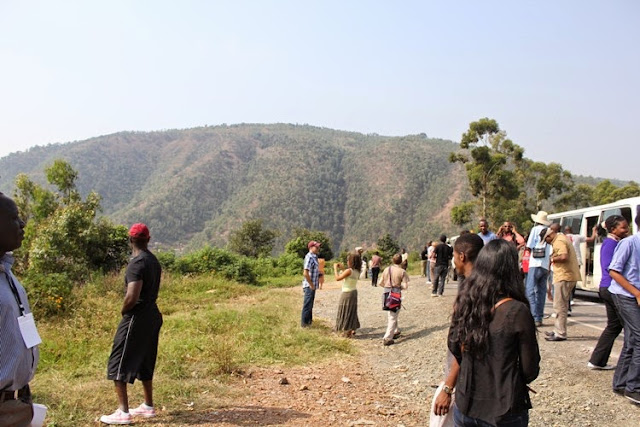Selous game reserve was officially established in 1896 during the German rule and given the name of the prior hunter Mr. Fredrick Courtney who died during the First World War and buried at Behobeho area in Matambwe sector.
Students from Wildlife Science University of Dar es Salaam receiving some of background history of Selous game Reserve, photo 2013
Currently the reserve is covering about 50,000 square kilometer, becoming the second wildest and largest in the world, it encompasses regions namely Morogoro, Lindi, Coast, and Ruvuma.
Some children from Kingupira village in Selous Game Reserve and Students from University of Dar es Salaam in Wildlife Science, photo 2012
Kingupira Wildlife research centre is located in the Selous game reserve (SGR), about 300 km from Dar es Salaam, The sector geographically is called North-Eastern sector is covering the area about 9,000 square kilometer, Ecologically the sector is divided into 6 blocks in order to simplify hunting activities as directed by the sustainable utilization policy.
Kingupira Research Center is located in the Selous game reserve 300 km from Dar es Salaam city
Among the researches done at Kingupira included one which was aimed to know cause of decrease in number of elephant populations, the main causes of their death are poaching activities due to insufficient of patrols due to lack of funds in different part of selous game reserve, and drought in area where they live because of lacking food and water.
Some students from Sokoine University and University of Dar es Salaam doing a research on cause of Death of Elephants population, photo 2013
Students from Wildlife Science from University of Dar es Salaam Some of poachers always look on Elephant trophies such as Elephant Tusks, photo 2013
To avoid this unexpected death of elephant population Tanzania government should increase funds and workers in the game reserve as well as improving power in anti-poaching activities.
Students from Wildlife science from University of Dar es Salaam during patrol in Selous Game Reserve, 2012 with one of the rangers
Selous Game Reserve especially in Kingupira sector there are other natural beauties including animals and plants
Hippopotamus in their habitat in Selous Game Reserve, photo 2013
Some of the African Elephants in Selous Game Reserve, photo 2013
In Selous game Reserve finding a baobab tree is not a miracle, Baobabs are deciduous trees ranging in height from 5 to 20 meters. The Baobab tree is a strange looking tree that grows in low-lying areas in Africa and Australia. It can grow to enormous sizes and carbon dating indicates that they may live to be 3,000 years old. Baobab tree is so large that up to 40 people can shelter inside its trunk.
A tree of Baobab in Selous Game Reserve, Kingupira Sector, photo 2013
In Selous Game Reserve Hunting tourism is a common activities where some Tourist use to collect some wild animals trophies for ornamentation including horns, skins and hooks of different animals such as buffalo, Elephant and some of antellope and crocodiles
This house is where all animals hunted are cleaned and stored before being sent to the owners as trophies
Some of trophy read to be used as ornament in Selous Game Reserve, Kingupira Sector
some of the important places in Kingupira sector include this place where you can see the hippopotamus and crocodiles swimming in the river
Hippopotamus swimming in Selous game Reserve, photo 2013
Some of Wildlife students from University of Dar es Salaam with a ranger enjoying to see some beauties of Selous game Reserve, Kingupira Sector, photo 2013
This house is a place for hiding the sun and rain while you are watching the Hippopotamus and Crocodiles, photo 2013
A good place for watching some of Wild animals in Selous Game Reserve, Kingupira Sector, photo 2013
This is a wet place where most of wild animals come to drink water during dry season, photo 2013
A good place for watching some of the birds found in Selous game Reserve and other wild animals, photo 2013
The views expressed are those of the author and are not necessarily of the scientific studies




















Comments
Post a Comment